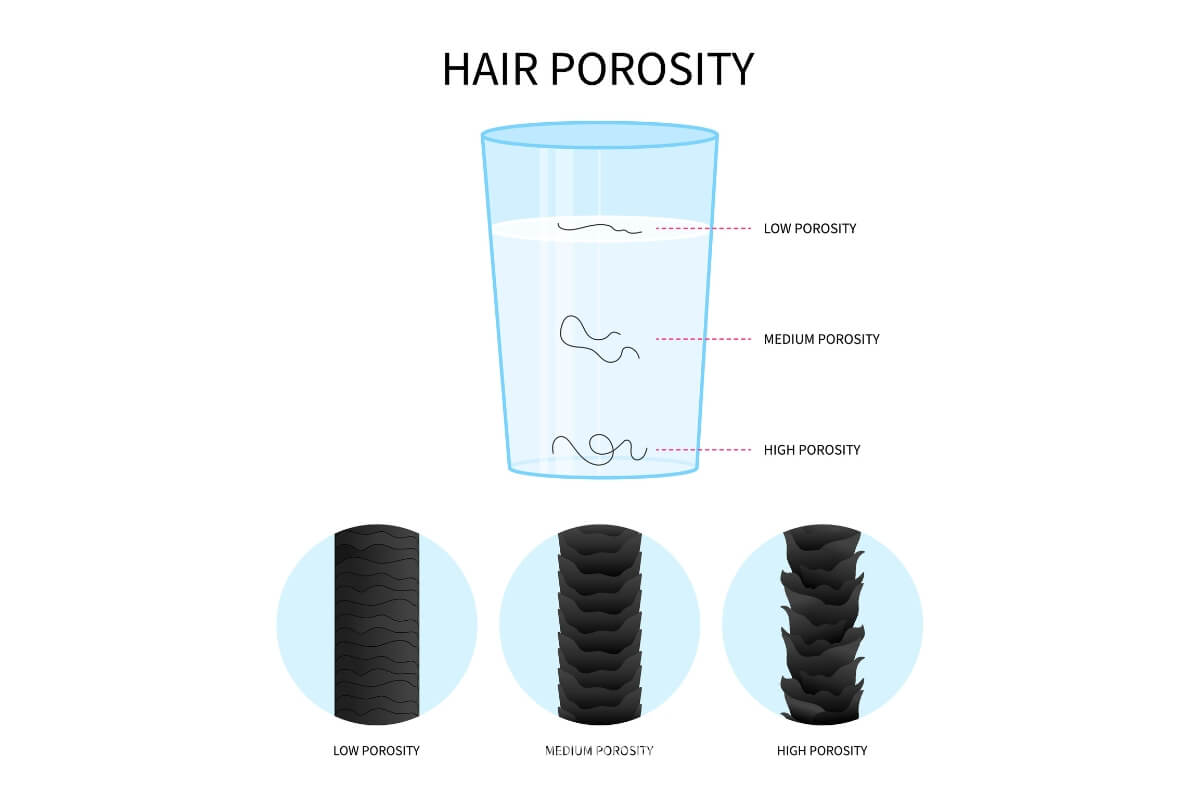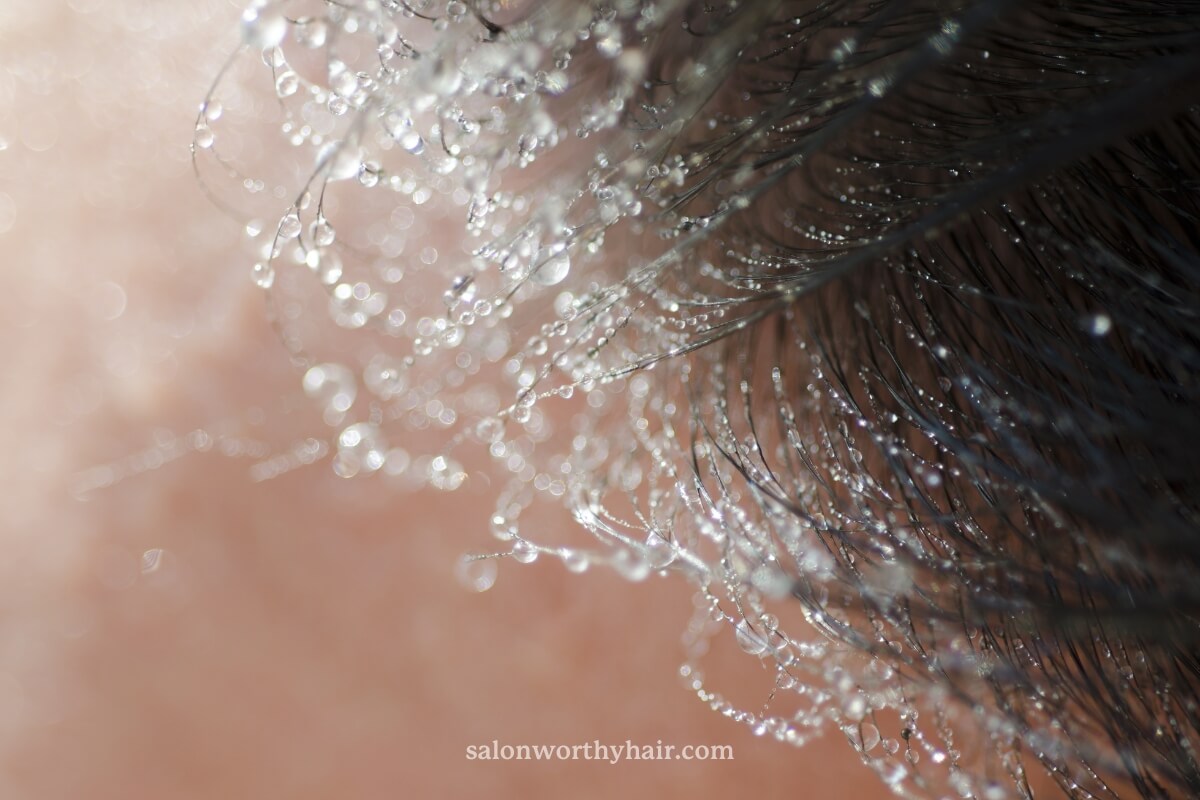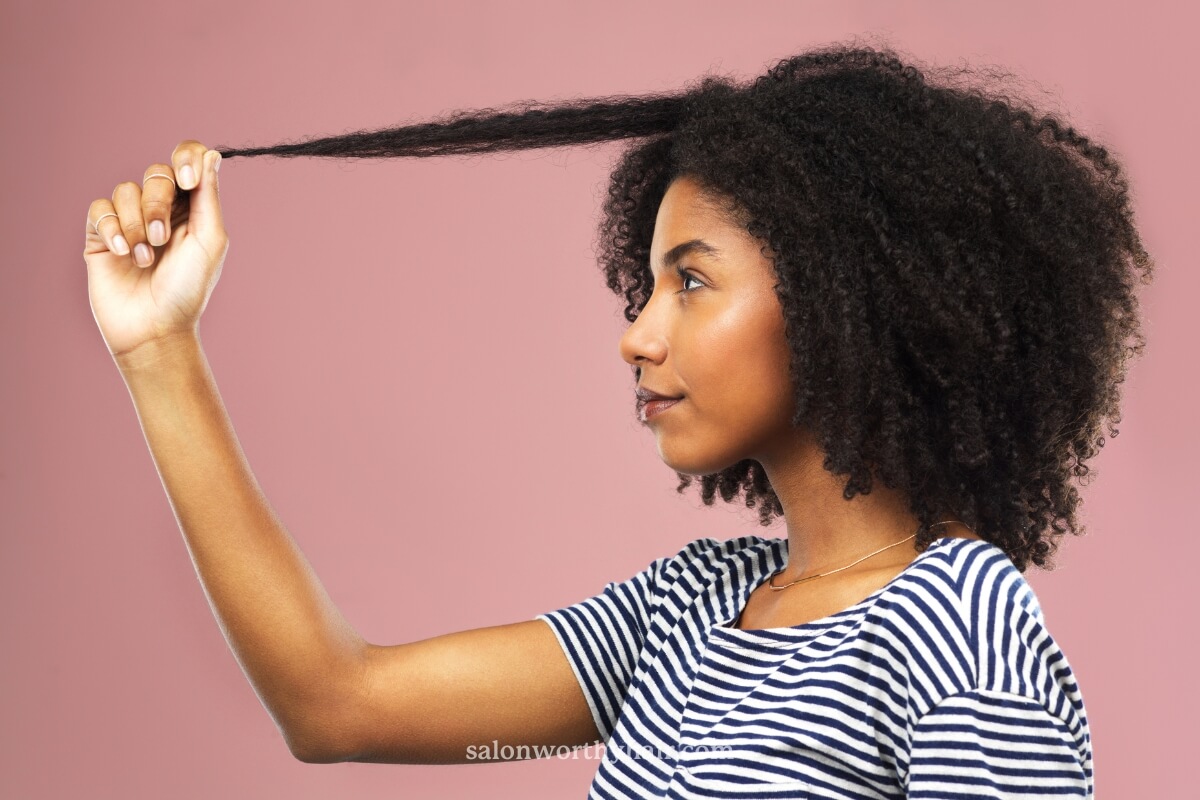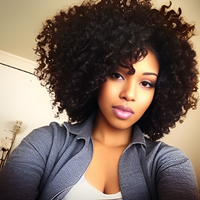Low Porosity Hair: Characteristics and Signs to Check for
Updated on
This post may contain affiliate links. As an Amazon Associate, we may earn from qualifying purchases.

Low porosity hair is a hair type characterized by its tightly bound cuticle layer.
This inherent attribute affects the hair’s texture, porosity level, elasticity, and moisture retention capabilities. It is the reason why hair with lower porosity requires the use of water-based products to absorb and prevent buildup.
If you suspect you have low porosity hair, here is a list of characteristics and traits to look for and adapt your haircare routine accordingly.
Closed and Compact Hair Cuticles
Low porosity hair has a dense and compact cuticle layer that does not lift easily.

The cuticle layer is the outermost layer of the hair shaft, consisting of scale-like cells that overlap each other. When the cuticle cells lie flat and smooth, they create a watertight compact barrier that impedes moisture from penetrating the hair shaft.
On the other hand, if the cuticle cells are raised or damaged, there are gaps and holes in the hair’s protective barrier that allow moisture to pass through.
The density and arrangement of the cuticle cells can vary depending on hair type, texture, hair care practices, and other external factors. In some cases, they may be too compact, and in others, too loose.
In order to properly assess a person’s hair porosity level, a cosmetologist or hairstylist uses the hair porosity classification method, which categorizes the hair into 3 distinct types of porosity levels:
- Low porosity hair
Hair’s cuticle is closed and flat. - Medium porosity hair
Hair’s cuticle cells are slightly open and evenly spaced out. - High porosity hair
Hair’s cuticle cells are too wide open.
For normal porosity hair, which is considered healthy hair, the cuticles can flex. They can open up to trap moisture and nutrients.
High porosity hair can also soak up moisture. But, unlike medium porosity hair, it cannot hold on to it for long due to the big gaps and holes that allow the moisture to leak.
In comparison to medium and high hair porosity, the less porous hair has a closely knit and constricted cuticle surface, which makes it harder for water and hair products to penetrate.
Hair Floats in Water

The easiest way to determine your hair’s porosity is by performing a hair porosity float test.
The test is simple.
Drop a piece of hair into a glass of clean water and observe if the hair sinks or floats after a few minutes.
To do this at home:
- Full up a glass with clean room temperature water,
- Grab a hair strand from anywhere on your head, or use a strand of hair that has naturally shed,
- Drop it into the glass of water,
- Watch how the hair behaves.
If the hair floats, it is low porosity. If it sinks, it is high porosity.
Please Note:
A float test may not always be reliable. Various factors like the surface tension of water, the hair’s thickness, how the hair is laid, and the shape of the hair can influence the results.
See our full guide on hair porosity tests with professional options.
Hair Is Moisture-Resistant

The compact and inflexible cuticle cells make low porosity hair impermeable to water and other forms of moisture.
That’s why low porosity is slow to absorb water, and often people with such hair types notice that their hair is not getting wet even after being in the shower for a while.
When selecting hair products, the “moisture resistance” characteristic of low porosity hair must be considered. The hair products must be able to infiltrate the cuticle layer, otherwise they would just sit on top causing buildup.
Hair Is Prone to Dryness
Low porosity hair tends to be dry and brittle.
Since the hair struggles to absorb moisture and nutrients, the lack of hydration can lead to dry, stiff, and brittle hair that is prone to breakage.
Other factors such as genetics, products, and hair care practices can also contribute to dryness in low porosity hair. For example, harsh shampoos that strip natural oils can exacerbate the condition.
To combat dryness in low porosity hair, using a deep conditioner and a hooded dryer can help.
Use a hooded dryer or a face or hair steamer device to warm up the hair follicles. Steam improves the hair’s ability to absorb by temporarily softening and loosening the cuticle cells. Steam provides an easy passage for moisturizing products to seep in. If you don’t have a steamer, apply the deep conditioner and put a shower cap on. This creates a greenhousing effect for hair by trapping body heat and increasing the temperature around the hair, which can help the conditioner to penetrate.
We may earn a commission from the links below.
Hair Tends to be Oily
Low porosity hair tends to be oily because the oil produced by the scalp is not evenly absorbed by the hair shaft due to its low porosity level.
I know this sounds contradictory to the above point, but oiliness is not the same as moisturizing.
In the case of low porosity hair, the sebum produced by the scalp, which is responsible for lubricating and protecting the full length of the hair, can accumulate on the surface of the hair and create a greasy appearance.
To help distribute sebum evenly, use a boar bristle brush. The brush’s natural bristles can pick up sebum from the scalp and evenly coat it along the length of the hair shaft.
Besides moisturizing and nourishing the hair, sebum coating also improves the overall hair texture.
Denman Boar Bristle Brush
Hair Products Sit on Top
When hair products are applied to low porosity hair, they may sit on top of the hair rather than being absorbed into the hair shaft.
One common sign of product buildup in low porosity hair is when shampoo seems to stick to the hair rather than rinse away.
Product buildup on low porosity hair can also be caused by several other factors, like heavy or thick hair products and infrequent washing or rinsing of the hair.
Lack of Elasticity When Hair Is Wet
Low porosity hair has reduced elasticity when it’s wet.
Elasticity refers to the hair’s ability to stretch and snap back to its original shape or curl pattern. It is an important trait that helps prevent hair damage during styling or manipulation. It allows the hair to bend, stretch, and twist without resisting.
Hair Is Prone to Tangles
Hair that lacks moisture can become dry, stiff, and brittle, which makes it prone to tangles.
Lack of flexibility and stiffness can cause the hair strands to rub against each other, leading to tangles and knots.
Applying oil to low porosity hair can help to some extent to prevent tangling by lubricating the hair strands, allowing them to glide past each other. However, it is important to note that low porosity hair can be resistant to oils too. Therefore, it is recommended to use lightweight oils and apply them sparingly, focusing on the ends of the hair rather than the scalp.
Regularly using a wide-tooth comb or bristle brush can also help prevent tangling in low porosity hair.
Recommended: Best oils for low porosity hair.Hair Takes Long Time to Dry
Low porosity hair has a slow drying time compared to healthier hair, particularly in humid conditions. Because it takes longer to get completely wet, it also takes longer for the water to evaporate.
To improve drying time for low porosity hair, use a blow dryer with lightweight hair products that do not weigh down the hair. You can also try techniques such as blotting or gently squeezing excess water from the hair to reduce drying time.
Hair Gets Weighed Down Easily
When hair products are applied to low porosity hair, they sit on the surface, causing the hair to feel heavy and greasy, and can make it challenging to achieve the desired hairstyles.
Most people with low porosity hair tend to follow natural hair care practices, like the Curly Girl Method, which emphasizes using lightweight hair products that don’t contain sulfates, silicones, and heavy oils. You can try a similar hair care routine to prevent your hair from feeling heavy and weighed down.
Hair Has Smooth Polished Texture
Low porosity hair, with a smoother cuticle layer, can give the hair a smoother and more polished texture. This can be especially noticeable in straight hair.
High porosity hair, on the other hand, with a rougher cuticle layer, can give the appearance of a coarse texture to the hair, which can be more noticeable in curly hair.
Hair Has Shiny Appearance
Due to the smooth and polished texture of the hair shaft, low porosity hair has a naturally shiny appearance. The compact cuticle layer of low porosity hair helps to reflect light more efficiently, giving the hair a shinier and more lustrous appearance compared to other hair types.
High porosity hair, in contrast, can’t reflect light as efficiently, making it look dull and lackluster.
Hair Is Resistant to Chemical Treatments
When chemical treatments such as hair dye or relaxers are applied to low porosity hair, they may not break into the hair shaft as they would with other hair types due to the compressed cuticle layer.
This makes the hair difficult to color until a pre-treatment is done to open the cuticles.
To improve the effectiveness of chemical treatments on low porosity hair, it’s important to prepare the hair beforehand by using steam, heat, or a clarifying shampoo to make the hair slightly porous for absorption.
Hair May Be Less Prone to Damage

The good thing about low porosity hair is that it may be less prone to damage compared to other hair types. The firm and tightly sealed cuticle layer can provide better protection to the hair’s inner layers from heat styling and chemical treatments.
To wrap up, here’s a summary of the unique features of low porosity hair:
- Tight and compact cuticle layer.
- Hair floats in water in a hair porosity float test.
- Smooth polished texture.
- Moisture resistant.
- Prone to dryness.
- Tendency to be oily.
- Hair products sit on top.
- Lack of elasticity.
- Takes a long time to dry.
- Gets easily weighed down.
- Resistant to chemical treatments.
- Less prone to damage.
- Shiny appearance.
About the Author
 Kayla Davis
Kayla DavisKayla Davis is a self-proclaimed skincare and haircare junkie who loves testing out new products and writing about her experiences. Her bathroom shelves are always overflowing with beauty products. You name it - it's there.


